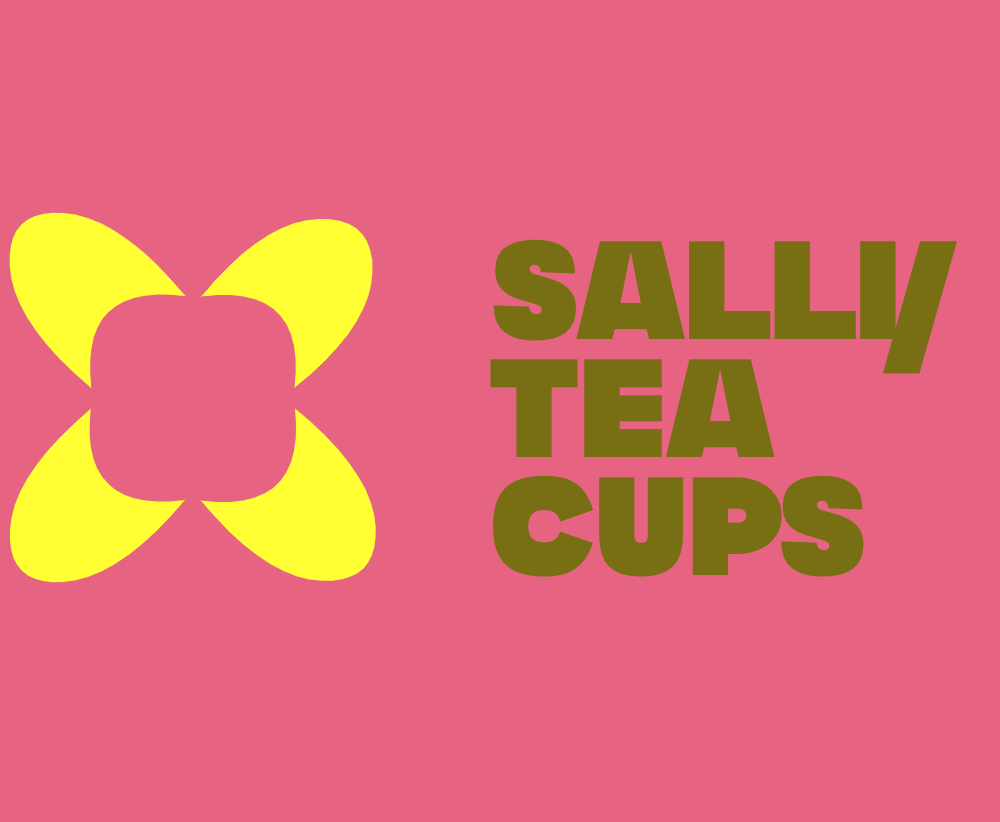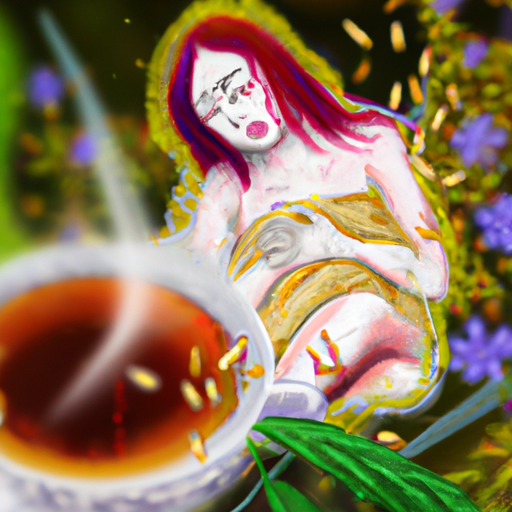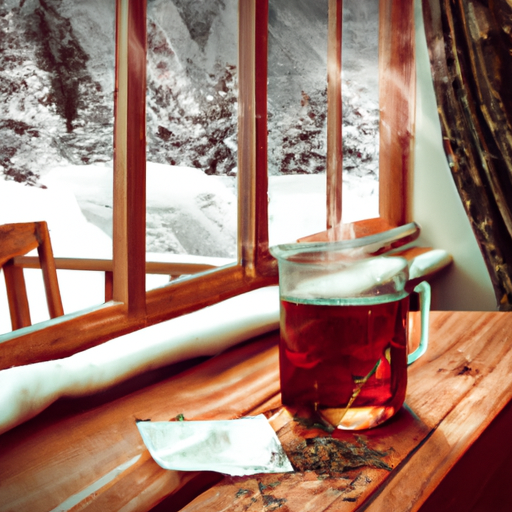Matcha Tea
What Temperature Should Water Be For Matcha

As someone who is passionate about matcha, I’ve learned through experience that crafting the ideal matcha cup isn’t just about using premium tea leaves; it also demands meticulous preparation. A crucial step in making matcha is ensuring the water temperature is precisely correct.
In this article, I will guide you through the ideal water temperature for matcha, as well as the traditional and modern methods of preparation to help you achieve the perfect cup.
Matcha is a finely powdered green tea that has been a part of Japanese tea culture for centuries. It is known for its vibrant green color, rich flavor, and numerous health benefits. While it is becoming increasingly popular in the West, many people are still unsure about how to prepare matcha properly.
Water temperature is crucial in bringing out the best flavor and texture of matcha, and by the end of this article, you will have a clear understanding of how to achieve the perfect temperature for your matcha.
Key Takeaways
- The ideal water temperature for matcha is around 175°F (80°C).
- Factors such as altitude, humidity, and type of tea leaves used can affect water temperature.
- Boiling water can scorch the delicate green tea leaves, while lukewarm water can result in a weak, insipid brew.
- Precision is key when it comes to water temperature, and fresh, high-quality, filtered water is preferred.
Brief Overview of Matcha
Let’s start with a brief overview of matcha and why it’s worth knowing what temperature your water should be. Matcha is a finely ground powder made from shade-grown green tea leaves. It has a rich, grassy flavor and is traditionally used in Japanese tea ceremonies.
Matcha has a long history, dating back to the Tang Dynasty in China. It was brought to Japan by Buddhist monks in the 12th century and has been an integral part of Japanese culture ever since.
In addition to its cultural significance, matcha also has numerous health benefits. It’s packed with antioxidants, which help to protect the body from free radical damage. It’s also high in catechins, a type of flavonoid that has been shown to have anti-inflammatory and anti-cancer properties. Matcha is also a great source of caffeine, providing a sustained energy boost without the jitters often associated with coffee.
Now that we understand the history and health benefits of matcha, let’s move on to the traditional Japanese preparation. To fully appreciate the flavor and aroma of matcha, it’s important to use the correct water temperature. The ideal temperature for matcha is around 175°F (80°C). This is slightly cooler than boiling water, which can scorch the delicate tea leaves and result in a bitter taste. By using the correct water temperature, you can ensure that your matcha is smooth, flavorful, and enjoyable to drink.
Traditional Japanese Preparation
In traditional Japanese matcha preparation, the ideal ratio of powder to liquid is 1 gram to 30 milliliters. This ratio ensures a smooth and velvety texture with a rich flavor that is not overpowering. To achieve this, the first step is to sift the matcha powder through a fine mesh strainer to remove any lumps and ensure a smooth consistency. Then, using a traditional bamboo scoop called a chashaku, measure out one scoop of matcha and place it in a ceramic bowl called a chawan.
Next, add hot water that is around 70-80°C, or just below boiling point. It is important to use water that is not too hot as it can result in a bitter taste, and not too cold as it will not properly dissolve the matcha powder. Once the water is added, use a bamboo whisk called a chasen to vigorously whisk the matcha in a zig-zag motion until a frothy layer forms on top. The chasen is also used to scrape the sides and bottom of the bowl to ensure all the powder is fully incorporated into the liquid.
In traditional matcha preparation, several traditional tools are used to ensure the perfect cup of matcha. These tools include a chashaku, chawan, chasen, and a fine mesh strainer. The chashaku is used to measure and add the matcha powder to the bowl, the chawan is the vessel in which the matcha is prepared and served, the chasen is used to whisk the matcha and create the frothy layer, and the fine mesh strainer is used to sift the matcha powder and remove any lumps. These tools are not only functional, but they also add to the aesthetic and cultural experience of enjoying matcha.
With the traditional matcha preparation process, one can appreciate the artistry and precision involved in creating the perfect cup of matcha. However, with modern variations of matcha, such as matcha lattes or matcha smoothies, the preparation process and tools used may differ.
Modern Variations
I want to talk about some modern variations of matcha that have become popular in recent years. These include iced matcha, matcha lattes, and matcha smoothies.
Iced matcha is a refreshing way to enjoy the traditional Japanese green tea, while matcha lattes and smoothies provide a creamy and sweet twist on the classic flavor. These variations offer a unique and delicious way to incorporate matcha into your daily routine.
Iced Matcha
Nothing beats the refreshing taste of iced matcha on a hot summer day. Not only does it provide a cool and delicious way to beat the heat, but it also offers a variety of health benefits. Iced matcha is packed with antioxidants, which help to protect the body against free radicals and reduce inflammation. It is also known to boost energy levels and improve mental clarity, making it the perfect pick-me-up for those long summer days.
To give you an idea of the different ways you can enjoy iced matcha, I have provided a table below outlining some popular variations. From classic iced matcha to matcha lemonade, there is a flavor for everyone to enjoy. So why not give it a try and discover your new favorite summertime drink?
| Type of Iced Matcha | Description |
|---|---|
| Classic Iced Matcha | A simple and refreshing way to enjoy matcha on ice. |
| Matcha Lemonade | A sweet and tangy twist on the classic iced matcha. |
| Matcha Smoothie | A creamy and delicious way to cool down with matcha. |
| Matcha Frappuccino | A frozen treat that combines the delicious taste of matcha with the texture of a blended drink. |
| Matcha Milkshake | A decadent dessert drink that combines matcha with vanilla ice cream and milk. |
As much as I love iced matcha, sometimes I crave something a bit more indulgent. That’s where matcha lattes come in.
Matcha Lattes
You’ll be surprised to know that matcha lattes have become one of the most popular drinks in coffee shops across the United States, with sales increasing by 39% in the last year alone. And it’s no wonder why! Matcha lattes are not only delicious, but they also offer a host of health benefits that make them a great alternative to traditional coffee drinks.
If you’re looking to make your own matcha latte at home, all you need is a few simple ingredients. Start by whisking together 1 teaspoon of matcha powder with 2 ounces of hot water until it forms a smooth paste.
Then, heat up 8 ounces of your milk of choice (almond milk is a great option) until it is hot but not boiling. Pour the milk into the matcha paste and stir until well combined.
Finally, add a touch of honey or agave nectar if you prefer a sweeter drink. Making your own matcha latte not only allows you to customize the ingredients to your liking, but it also gives you the added benefit of knowing exactly what’s in your drink.
So why not give it a try and enjoy the many benefits of this delicious and healthy beverage? Speaking of healthy beverages, let’s move on to the next section and talk about matcha smoothies.
Matcha Smoothies
Now that we’ve explored the world of matcha lattes, let’s move on to another delicious way to incorporate matcha into your daily routine: matcha smoothies. Matcha smoothies have become increasingly popular in recent years, and for good reason.
Not only do they offer a refreshing and healthy alternative to traditional smoothies, but they also provide all the benefits of matcha in a convenient and tasty package. There are countless matcha smoothie recipes out there, but some of the most popular include ingredients like banana, almond milk, spinach, and of course, matcha powder.
Adding matcha to your smoothie not only enhances the flavor, but it also provides a boost of antioxidants and natural energy. In fact, matcha is known to contain even more antioxidants than regular green tea, making it a great addition to any healthy diet.
So next time you’re looking for a refreshing and nutritious snack, consider whipping up a matcha smoothie.
Moving on to the next topic, let’s discuss the factors that affect water temperature when preparing matcha.
Factors Affecting Water Temperature
One thing to consider when preparing matcha is how factors like water temperature can affect the taste and quality of your tea. Water temperature is a crucial element when making matcha, as it can either enhance or ruin the flavor of your tea.
The ideal water temperature for matcha is between 160°F to 180°F, as boiling water can scorch the delicate green tea leaves, while lukewarm water can result in a weak, insipid brew.
The factors that affect water temperature for matcha include altitude, humidity, and the quality of the water you use. If you live in a high-altitude area, you may need to adjust your water temperature to a lower degree to achieve the right consistency.
Additionally, the humidity in the air can affect the temperature of your water, so it’s best to keep your matcha-making environment dry and cool. Lastly, the quality of the water you use is just as important as the temperature itself. High-quality water that is pure and free from contaminants will result in a better-tasting matcha.
Water temperature is a vital factor to consider when making matcha, as it can affect the flavor and quality of your tea. Factors such as altitude, humidity, and water quality can all impact the temperature of your water, so it’s necessary to take these into account when preparing your matcha.
In the next section, we’ll discuss the ideal water temperature for matcha and how to achieve it.
Ideal Water Temperature
To get the perfect flavor for your matcha, it’s crucial to heat the water until it’s just before boiling. The ideal water temperature for matcha is between 175°F and 180°F. The water temperature has a significant effect on the flavor and color of the matcha, so it’s essential to get it right.
Here are some factors to consider when testing the water temperature for matcha:
-
Water temperature affects the flavor: If the water is too hot, the matcha will taste bitter. If the water is too cold, the matcha will be bland and watery.
-
Water temperature affects the color: The hotter the water, the brighter the green color of the matcha will be. If the water is too cold, the matcha will be a dull green color.
-
Testing the water temperature is important: To ensure that the water is at the ideal temperature, it’s important to use a thermometer. Boiling water should be left to cool for a few minutes before adding it to the matcha.
The water temperature is just one factor that affects the taste of matcha. Another important factor is water quality.
(Note: See subsequent section about the importance of water quality for more information.)
Importance of Water Quality
Ensuring that you use high-quality water when making your matcha is vital for achieving the best taste and color. Water plays a crucial role in the preparation of matcha, and it’s essential to use water that’s pure and clean.
The quality of water can affect the taste and color of matcha, so it’s necessary to pay attention to the water you use. Water filtration is an essential aspect of water quality. It’s crucial to use filtered water to remove any impurities that may alter the taste of matcha.
Impurities such as chlorine, lead, and other minerals can affect the flavor of matcha. Additionally, using water with a high mineral content can make matcha taste harsh and astringent. Therefore, it’s recommended to use water with low mineral content, so the natural flavor of matcha can shine through.
The quality of water is an important factor when making matcha. Water filtration and mineral content play a significant role in the taste and color of matcha. Using high-quality water will ensure that you get the best out of your matcha.
Now, we’ll move on to the next section, where we’ll discuss how to prepare the water for the perfect matcha.
Preparing the Water
Get ready for the perfect cup of matcha by prepping your H2O. It’s not just about using clean water, but also achieving the right temperature. Boiling water may seem like the easiest option, but it’s not always the best choice.
Here are a few things to keep in mind when preparing your water for matcha:
-
Filtered water is preferred for matcha preparation because it removes impurities that can affect the taste and quality of the tea. Tap water can contain chemicals like chlorine or heavy metals that can alter the taste, so it’s best to use filtered water if possible.
-
The temperature of the water is crucial when making matcha. Using boiling water can scorch the delicate tea leaves and result in a bitter taste. The ideal temperature for matcha is around 175°F to 180°F (79°C to 82°C), which is just below boiling point. If you don’t have a thermometer, a good rule of thumb is to let the water cool for a few minutes after boiling before using it for matcha.
-
Precision is key when it comes to the temperature of the water. Even a few degrees too hot or too cold can make a significant difference in the taste of your matcha. It’s worth investing in a thermometer to ensure that you’re getting the best possible results.
-
Remember to always use fresh water for matcha. Reboiling water can affect its oxygen content and alter the taste of your tea. So, it’s recommended to use freshly boiled water every time you make matcha.
Now that you’ve prepped your water perfectly, it’s time to move on to preparing the matcha itself.
Preparing the Matcha
You’re eagerly anticipating the moment when you can finally savor the rich flavors of your matcha, and the next step is crucial to achieving the perfect cup.
One of the most important factors in preparing matcha is the water quality. Using high-quality water is essential to bring out the full flavor of the tea. It’s recommended to use filtered water or spring water to ensure that there are no impurities that could affect the taste.
After you’ve heated the water to the correct temperature, it’s time to start preparing the matcha. First, you’ll need to measure out the desired amount of matcha powder into a bowl. The amount of matcha will depend on your personal preference and the size of the bowl. Generally, one teaspoon of matcha powder is enough for a standard bowl of matcha.
Once you’ve measured out the matcha powder, it’s time to whisk it into the water. To achieve the perfect consistency and froth, it’s important to use the correct whisking technique. Hold the whisk firmly in one hand and use the other hand to hold the bowl. Use a quick back-and-forth motion to whisk the matcha until it becomes frothy.
With the matcha prepared, it’s time to move onto the next step of the process and start whisking the matcha.
Whisking the Matcha
Now it’s time to start whisking the matcha and experience the creamy, frothy goodness that will awaken your taste buds. The whisking technique is crucial in achieving the perfect froth consistency for your matcha.
First, use a bamboo whisk or chasen to sift the matcha powder into a bowl. This helps to break up any clumps and ensures a smooth texture.
Next, add hot water that has been heated to around 175-180°F (80-82°C) to the bowl. Using the whisk, make a quick back-and-forth motion in a ‘W’ shape to create a froth on the surface. Be sure to whisk vigorously for about 15-20 seconds to achieve the desired consistency. The froth should be thick and creamy, with tiny bubbles evenly distributed throughout.
Take a moment to appreciate the beautiful green color and aroma of your matcha. This vibrant drink is not only delicious but also packed with antioxidants and other health benefits.
Now that your matcha has been whisked to perfection, it’s time to move onto serving and enjoying your matcha.
Serving and Enjoying Your Matcha
To fully appreciate the flavor of matcha, it’s important to use a traditional matcha bowl, or chawan, which is wider and shallower than a regular tea cup. The chawan is specifically designed to enhance the aroma and flavor of matcha.
When serving matcha, it’s important to use the right utensils and follow proper matcha ceremony etiquette. Before serving matcha, make sure that the water temperature is at the optimal range of 160°F to 175°F. If the water is too hot, it can cause the matcha to become bitter. If it’s too cold, the matcha won’t fully dissolve and will result in a grainy texture. To achieve the perfect temperature, boil water and let it sit for a few minutes before pouring it into the matcha bowl.
When it comes to enjoying your matcha, there are a few things to keep in mind. First, hold the chawan with both hands as a sign of respect. Second, take a moment to appreciate the aroma before taking a sip. Finally, make sure to drink all of the matcha in the bowl, as it’s considered impolite to leave any behind.
By following these matcha ceremony etiquette guidelines, you’ll be able to fully appreciate the rich taste and history of this ancient beverage.
Frequently Asked Questions
What are the health benefits of drinking matcha?
As someone who regularly drinks matcha, I can attest to its numerous health benefits. Matcha contains high levels of antioxidants, which can help protect against chronic diseases such as cancer and heart disease. It’s also known to improve cognitive function and boost metabolism.
When preparing matcha, it’s important to use high-quality ceremonial grade powder and to whisk it vigorously with hot water until it becomes frothy. Adding a touch of sweetener or milk can also enhance the flavor.
Overall, incorporating matcha into your diet can provide a multitude of health benefits and is a delicious and easy addition to any routine.
How long does matcha stay fresh?
Matcha is a delicate tea that needs to be stored properly to maintain its freshness. When storing matcha, it’s important to keep it away from light, heat, and air. The best way to store matcha is in an airtight container that’s kept in a cool, dry place. This will help prevent the matcha from oxidizing and losing its flavor.
The shelf life of matcha can vary depending on how it’s stored, but it typically lasts for up to a year. If you find you have leftover matcha powder, you can reuse it for cooking or baking. However, it’s important to note that the quality and flavor of the matcha may not be the same as when it was first opened.
Overall, proper storage and understanding the shelf life of matcha can help ensure you’re getting the best flavor and health benefits from this popular tea.
Can I use regular tap water to make matcha?
When it comes to making matcha, the type of water you use can greatly affect the taste and overall quality of the drink. Filtered water is generally recommended over tap water, as it can remove any impurities and provide a cleaner taste.
Spring water is also a good option for those looking for a more natural taste. As for the temperature, it’s important to avoid using boiling water, as this can scorch the delicate matcha powder and create a bitter taste. Instead, opt for water that is around 175°F, or roughly the temperature of a hot shower.
This will allow the matcha to dissolve properly and create a smooth, creamy texture. Overall, taking the time to choose the right water and temperature can make a big difference in the final result of your matcha.
Is there a specific type of whisk recommended for making matcha?
When it comes to making matcha, there are two main types of whisks: bamboo and electric. Both have their pros and cons, but ultimately it depends on personal preference.
Bamboo whisks are traditional and provide a more authentic experience. They also create a frothier consistency, which is desirable for many matcha enthusiasts.
On the other hand, electric whisks are convenient and require less effort. They also tend to create a smoother consistency.
Regardless of which whisk you choose, it’s important to properly clean it after each use. To do so, rinse it with warm water and gently pat it dry with a towel. Avoid using soap or scrubbing too hard, as this can damage the whisk.
With the right whisk and proper cleaning techniques, you’ll be able to enjoy a delicious cup of matcha every time.
How many servings of matcha can I make with one teaspoon of matcha powder?
After conducting some research, I’ve found that the recommended teaspoon measurement for making matcha is about 1 teaspoon per 8 ounces of water. However, this can vary depending on personal preference and the strength of the matcha powder being used.
In terms of water ratio, it’s recommended to use 2 ounces of water for every 1 teaspoon of matcha powder. This will typically yield one serving of matcha.
It’s important to note that the quality of the matcha powder can also affect the number of servings you can make with one teaspoon. It’s best to experiment with different measurements and water ratios to find the perfect balance for your taste.
Conclusion
As I’m sipping my perfectly prepared matcha, I can’t help but feel a sense of tranquility wash over me. The vibrant green hue of the tea symbolizes the rejuvenation and vitality it brings to my mind and body.
The careful attention paid to the water temperature during preparation is a symbol of the respect and appreciation for this centuries-old tradition. Matcha is not just a drink, it’s a symbol of Japanese culture and history.
With the right water temperature and preparation, it can transport you to a place of calmness and mindfulness. So next time you prepare your matcha, take a moment to reflect on the symbolism behind it and savor every sip.
Matcha Tea
Matcha Powder Where To Buy
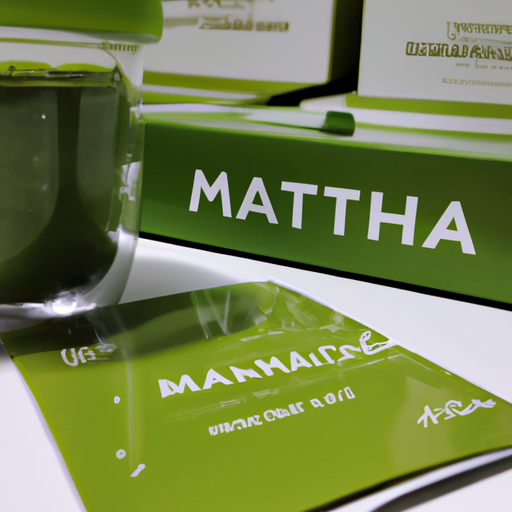
As someone who loves green tea and cares about their health, I am constantly searching for the highest quality matcha powder. Matcha powder is a bright green powder that is produced from tea leaves grown in the shade. It is renowned for its various health benefits, such as increasing metabolism, enhancing concentration, and offering antioxidants.
If you’re wondering where to buy matcha powder, here are some options to consider. One of the easiest places to find matcha powder is health food stores. These stores typically offer a selection of high-quality matcha powders that are organic and free from additives.
Online retailers are also a great option for purchasing matcha powder. They offer a wide variety of brands and grades to choose from, and you can easily compare prices and read customer reviews before making a purchase.
Japanese specialty stores, farmers markets, and tea shops are also worth checking out for a unique and authentic matcha powder experience. When it comes to buying matcha powder, there are a few things to keep in mind, such as price, quality, and customer reviews.
By doing some research and exploring different options, you’ll be sure to find the perfect matcha powder for your needs.
Key Takeaways
- Matcha powder comes in different grades and quality indicators include color, texture, and aroma.
- It is important to prioritize quality over price when choosing matcha powder and to choose a brand that is organic and high-quality.
- Different grades of matcha will come at different price points and it’s important to consider the flavor profile when purchasing.
- Matcha powder can be purchased at health food stores, online retailers, Japanese specialty stores, farmers markets, and tea shops, and customer reviews and ratings provide valuable insights into product quality.
The Benefits of Drinking Matcha Powder
Looking for a delicious way to boost your health? Look no further than matcha powder – it’s packed with antioxidants and helps improve brain function!
Matcha powder benefits are plentiful, and it’s no wonder that it has become such a popular health drink. One of the primary health advantages of matcha is its high concentration of antioxidants, which help protect the body from damage caused by free radicals. These harmful molecules can cause inflammation and damage to cells, which can lead to chronic diseases such as cancer and heart disease.
In addition to its antioxidant properties, matcha powder also contains caffeine and the amino acid L-theanine, which work together to improve brain function. While caffeine provides an energy boost, L-theanine promotes relaxation and reduces the jittery effects often associated with caffeine consumption. This combination can lead to increased focus, alertness, and productivity.
So, where can you find matcha powder? Health food stores are a great place to start. They often carry a variety of matcha products, including loose tea leaves and pre-made drinks. Some grocery stores may also carry matcha powder in their health food section.
With its numerous health benefits and delicious taste, matcha powder is definitely worth a try!
Health Food Stores
If you’re into healthy eating, you’ve probably already checked out your local health food store. Health food stores are great places to find organic options for your matcha powder needs. Not only do they carry high-quality products, but they also offer a wide range of health supplements, vitamins, and organic food choices.
To help you find the best health food stores near you, I’ve created a table with some local options and their locations. Keep in mind that some of these stores may not carry matcha powder, but they are worth checking out for other healthy options.
| Store Name | Location |
|---|---|
| Whole Foods Market | Multiple Locations |
| Natural Grocers | Multiple Locations |
| Sprouts Farmers Market | Multiple Locations |
When it comes to buying matcha powder, it’s important to choose a brand that is organic and high-quality. Health food stores often carry these types of products, making it easier for you to find a matcha powder that meets your standards. Additionally, shopping at local health food stores supports small businesses in your community.
Now that you know where to find matcha powder at health food stores, let’s explore the option of buying from online retailers.
Online Retailers
When it comes to buying matcha powder online, there are a few options to consider. First and foremost, Amazon has a wide variety of matcha brands available for purchase.
Additionally, there are many matcha-specialty websites that offer high-quality matcha powder and tea accessories. As someone who enjoys matcha, I’ve found that these online retailers are a convenient and reliable way to stock up on my favorite green tea.
Amazon
You can’t go wrong with Amazon when it comes to finding the perfect matcha powder for your next cup of tea. They offer a wide variety of matcha powder brands, both organic and non-organic, so you can choose what fits your preferences and budget.
You can easily compare prices, read reviews from other customers, and even check the country of origin of the matcha powder you’re interested in purchasing. In addition, Amazon often offers promotions and discounts on matcha powder, making it a great place to find a deal.
However, if you’re looking for a more specialized selection of matcha powder or want to support smaller businesses, you might want to check out matcha-specialty websites.
Matcha-Specialty Websites
Explore matcha-specialty websites to discover unique and high-quality options that will elevate your tea-drinking experience and leave you feeling satisfied with your purchase. These websites specialize in matcha powder, offering a wide range of products from different regions of Japan. They also provide detailed information on the type of matcha, its origin, and how it’s processed.
Apart from offering matcha powder, these websites also provide recipes and information on the traditional Japanese tea ceremony. You can learn how to make matcha lattes, smoothies, desserts, and other delicious treats. Additionally, they offer tips on how to prepare matcha, including the proper way to whisk the powder and how to serve it in a traditional tea bowl.
With the help of these matcha-specialty websites, you can not only purchase high-quality matcha powder but also learn about its history and culture.
Moving on to Japanese specialty stores, they’re also a great option for purchasing matcha powder. These stores offer a wide range of Japanese products, including matcha powder, tea sets, and other traditional items. With their authentic products and knowledgeable staff, these stores provide a unique shopping experience for anyone interested in Japanese culture.
Japanese Specialty Stores
If you’re a matcha lover, you simply must check out Japanese specialty stores for the most incredible selection of matcha powders you’ve ever seen! These stores offer a wide range of matcha powders, each with its own unique flavor and texture.
What’s more, Japanese specialty stores can provide you with an authentic matcha experience, complete with information on Japanese tea ceremonies and the cultural significance of matcha. Matcha is an integral part of Japanese culture, and Japanese specialty stores take pride in offering only the highest quality matcha powders.
These stores source their matcha from the best tea plantations in Japan, ensuring that you get the most authentic and flavorful matcha powder possible. They also offer a variety of grades, from ceremonial grade to culinary grade, so you can choose the perfect matcha powder for your needs.
In addition to matcha powders, Japanese specialty stores also offer matcha accessories such as bamboo whisks and bowls. These tools are essential for preparing matcha in the traditional way, and using them can enhance your matcha experience.
So, if you’re looking for the best matcha powder and an authentic matcha experience, be sure to visit your local Japanese specialty store.
Visiting a Japanese specialty store is just one way to find high-quality matcha powder. Next, let’s explore another option: farmers markets.
Farmers Markets
At farmers markets, you’ll come across an array of locally-sourced and fresh produce, including ingredients that can complement your matcha drink. Here are four ways to make the most of your farmers market visit:
- Look for fresh fruits like berries or citrus that can add a sweet and tangy taste to your matcha.
- Consider adding some local honey as a natural sweetener that can enhance the flavor of your matcha.
- Check out the selection of local dairy products such as milk or cream that you can use to make a creamy matcha latte.
- Be on the lookout for organic herbs like mint or lavender that can be added to your matcha for an extra boost of flavor and relaxation.
Local availability is a major benefit of shopping at farmers markets. You can find ingredients that are grown and harvested in your area, which means they’re fresher and have a lower carbon footprint. Additionally, farmers markets typically offer organic options, which are free from harmful pesticides and chemicals.
If you can’t find matcha powder at the farmers market, don’t worry. There are plenty of tea shops that sell high-quality matcha powder. But before we dive into that, let’s explore another option for sourcing matcha – online retailers.
Tea Shops
Don’t overlook the convenience of purchasing matcha from specialty tea shops, as they often carry a variety of grades and flavors to suit your preferences. These shops specialize in various tea blends, and their knowledgeable staff can help you understand the differences between the grades of matcha powder available. They can also provide guidance on the best brewing methods to ensure you get the most out of your matcha experience.
When searching for matcha powder, it’s essential to consider the grade of the powder you’re purchasing. The higher the grade, the better the quality, and the more expensive it tends to be. Some tea shops offer ceremonial-grade matcha powder, which is the highest quality and is typically used in traditional Japanese tea ceremonies. However, you can also find culinary-grade matcha powder, which is cheaper and is suitable for baking and cooking.
When purchasing matcha powder from a tea shop, it’s also important to consider the flavor of the matcha. Some blends are sweeter or have a more robust flavor than others, and the staff can help you choose the right flavor profile for your taste preferences.
Next, we’ll discuss what to look for when purchasing matcha powder in more detail.
What to Look for When Buying Matcha Powder
Ensure you get the best matcha experience by choosing the right grade and flavor profile to suit your taste buds. Quality indicators play a significant role in determining the quality of matcha powder.
Look for the color, texture, and aroma of the powder. High-quality matcha powder should have a vibrant green color, fine texture, and a pleasant aroma.
Matcha grades are another important factor to consider when selecting the right matcha powder. The higher the grade, the better the quality and flavor profile. The most commonly available grades are ceremonial, premium, and culinary.
Ceremonial grade matcha is the highest quality and is best used for traditional tea ceremonies. Premium grade is suitable for daily consumption, while culinary grade is ideal for cooking and baking.
With so many brands and varieties of matcha powder available, it can be challenging to choose the right one. It’s important to do your research and compare prices before making a purchase.
In the next section, we’ll discuss price comparison and where to buy matcha powder.
Price Comparison
When it comes to purchasing matcha, it’s important to shop around and compare prices like a savvy consumer. However, it’s important to keep in mind that the quality of matcha powder can vary greatly, and different grades of matcha will come at different price points.
The highest quality matcha powder, ceremonial grade, will typically be the most expensive. This is because it’s made from the youngest tea leaves that are shade-grown and hand-picked. The result is a bright green color, smooth taste, and high concentration of antioxidants.
On the other hand, culinary grade matcha powder will be less expensive because it’s made from older leaves and has a slightly bitter taste.
When comparing prices, it’s important to keep in mind which grade of matcha powder you’re looking for. While it may be tempting to opt for a cheaper option, it’s important to prioritize quality and ensure that you’re getting the most out of your matcha experience.
By doing your research and considering different options, you’ll be able to find a matcha powder that fits your budget without sacrificing quality.
Moving on to customer reviews and ratings, it’s important to take these into consideration when making a purchase. While price is certainly a factor, hearing from other consumers about their experiences with a particular brand or product can provide valuable insight into the quality and taste of matcha powder.
Customer Reviews and Ratings
Now that we’ve looked at the various prices of matcha powder available in the market, it’s time to delve deeper into what matters most – the product quality. As someone who values my health and well-being, I always make sure to read customer reviews and ratings before making a purchase. This helps me get an idea of the product quality and what to expect from it.
In this current subtopic, we will explore the importance of customer reviews and ratings when it comes to buying matcha powder, and how it can help us make an informed decision.
Firstly, customer reviews and ratings provide us with valuable insights into the product quality. By reading the experiences of other customers who have already tried the product, we can get an idea of its taste, texture, and overall quality. This can help us determine whether the matcha powder is worth the investment or not. Additionally, customer reviews can also inform us about any potential side effects or issues that may arise from using the product, allowing us to make an informed decision before purchasing.
Secondly, customer reviews and ratings can also help us choose the right brand. With so many options available in the market, it can be overwhelming to choose the right brand of matcha powder. However, by reading customer reviews and ratings, we can get an idea of which brands are trustworthy, reliable, and offer high-quality products. This can save us from the hassle of trying out different brands and potentially wasting our money on subpar products.
Reading customer reviews and ratings is crucial when it comes to buying matcha powder. It not only helps us understand the product quality but also helps us choose the right brand. So, the next time you’re looking to buy matcha powder, make sure to read customer reviews and ratings to make an informed decision.
Frequently Asked Questions
How much matcha powder should I consume per day?
When it comes to consuming matcha powder, the recommended dosage is typically 1-2 teaspoons per day. However, it’s important to note that the amount you should consume depends on your individual health needs and goals.
Consuming matcha powder regularly can have numerous health benefits, including boosting metabolism, improving brain function, and enhancing heart health. Matcha powder is also a great source of antioxidants, which can help protect your body against free radicals and potentially reduce the risk of chronic diseases.
It’s important to ensure that you’re purchasing high-quality matcha powder from a reputable source to maximize its health benefits.
Can matcha powder be used in cooking or baking?
Matcha powder is a versatile ingredient that can be used in a variety of dishes, both sweet and savory. When it comes to baking, matcha powder can add a unique and delicious flavor to cakes, cookies, and even bread. The vibrant green color of matcha can also be a beautiful addition to any dessert.
In savory dishes, matcha powder can be incorporated into sauces, marinades, and dressings. It can even be used as a seasoning for vegetables or meats. The possibilities are endless! However, it’s important to note that a little goes a long way with matcha powder, as its flavor can be quite strong.
So, when using matcha in your cooking or baking, be sure to start with a small amount and adjust to taste.
What is the difference between ceremonial grade and culinary grade matcha powder?
When it comes to matcha powder, there are two main grades to consider: ceremonial and culinary.
Ceremonial grade matcha is of the highest quality and is made from the youngest tea leaves that have been carefully shaded before harvest. This process results in a bright green color and a smooth, delicate flavor. It’s typically used in traditional tea ceremonies and is enjoyed on its own without any added ingredients.
Culinary grade matcha, on the other hand, is made from slightly older tea leaves that have not been shaded, resulting in a less vibrant green color and a slightly bitter taste. It’s often used in cooking and baking, where its flavor can be masked by other ingredients.
While both grades can be used in a variety of ways, the difference in quality is significant, with ceremonial grade being the superior option for drinking as a tea.
How long can I store matcha powder and what is the best way to store it?
Storing matcha powder properly is crucial to maintaining its quality and flavor. As for the shelf life of matcha powder, it can last up to a year if stored correctly.
The best way to store matcha powder is to keep it in an airtight container in a cool and dark place, away from heat, light, and moisture. It’s also essential to prevent any contact with air as oxidation can affect the taste and color of matcha powder.
It’s not recommended to keep matcha powder in the refrigerator or freezer as the moisture and temperature changes can cause condensation and affect the quality of the powder.
Following these tips and advice for storing matcha powder can help extend its shelf life and maximize its flavor potential.
Are there any potential side effects or risks associated with consuming matcha powder?
When it comes to consuming matcha powder, it’s important to be aware of potential side effects and health risks. While matcha contains many beneficial antioxidants and nutrients, it also contains caffeine, which can lead to negative effects such as jitters, anxiety, and insomnia in individuals who are sensitive to it.
It’s important to determine your tolerance for caffeine before consuming matcha regularly. Additionally, matcha may interact with certain medications or supplements, so it’s important to consult with a healthcare provider before incorporating it into your daily routine.
Overall, moderation and caution are key when consuming matcha powder.
Conclusion
In conclusion, buying matcha powder can be a daunting task, but with the right knowledge, it can be an enjoyable experience. The benefits of drinking matcha powder are numerous, and it’s no wonder it’s become a popular health drink.
Whether you choose to purchase from health food stores, online retailers, Japanese specialty stores, farmers markets, or tea shops, there are many options available to you. When buying matcha powder, be sure to consider factors such as price, quality, and customer reviews and ratings. It’s important to do your research to ensure that you’re getting the best product for your money.
So, whether you’re a matcha enthusiast or just starting out, take the time to explore your options and find the perfect matcha powder for you. With so many benefits to be gained, it’s definitely worth the effort.
Matcha Tea
Matcha When Pregnant
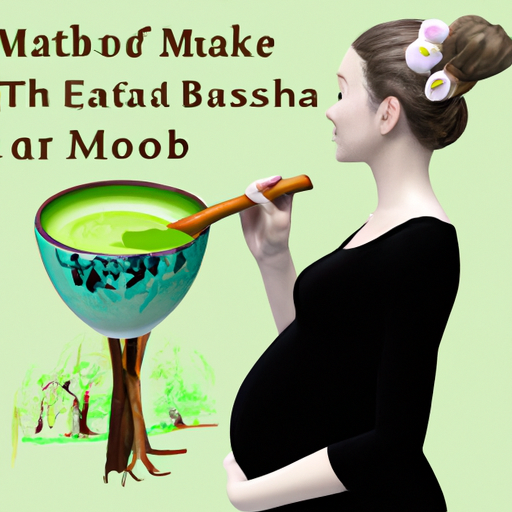
As an expectant mother, I recognize the significance of maintaining a nutritious and balanced diet throughout pregnancy. With a plethora of food choices available, it can be daunting to determine what to consume and what to steer clear of.
One popular beverage that has gained popularity in recent years is matcha. But is it safe to consume matcha during pregnancy?
Matcha, a type of green tea, has numerous health benefits including increased energy, improved mental focus, and a boost in metabolism. However, as with any food or beverage during pregnancy, there are potential risks to consider.
In this article, we will explore the benefits and risks of consuming matcha during pregnancy, as well as research on the topic and factors to consider before adding matcha to your diet. We will also provide safe levels of matcha consumption during pregnancy, alternatives to matcha, precautions to take while consuming matcha, and even matcha recipes safe for pregnant women.
Key Takeaways
- Matcha can provide antioxidants, vitamins, and minerals for healthy development during pregnancy.
- Safe levels of matcha consumption during pregnancy are limited to no more than two cups per day, and should be avoided in the first trimester due to caffeine content.
- Heavy metal contamination is a risk, so it’s important to choose tested products of high quality and produced in a clean environment.
- Matcha may interfere with nutrient absorption, especially green tea tannins binding to minerals, so it’s important to consult a healthcare professional before consuming matcha during pregnancy.
Benefits of Matcha Consumption During Pregnancy
You’re going to love knowing that drinking matcha during pregnancy can provide you and your growing baby with a boost of antioxidants, vitamins, and minerals that support healthy development. The high levels of catechins, which are antioxidants found in matcha, can help protect your body from cell damage caused by harmful free radicals. Matcha is also packed with vitamins A, C, and E, which are essential for a healthy immune system and can help support your baby’s growth and development.
Incorporating matcha into your diet during pregnancy is easy and delicious. You can enjoy matcha in a variety of ways, including hot or cold matcha tea, smoothies, and even baked goods. There are countless matcha recipes available online that are specifically designed for pregnant women, so you’ll have no trouble finding a recipe that you love.
While matcha is generally considered safe for pregnant women to consume, it’s important to keep in mind that everything should be consumed in moderation. Too much caffeine can be harmful to both you and your growing baby, so it’s important to limit your intake of matcha to no more than two cups per day. With that said, drinking matcha in moderation during pregnancy can provide a wide range of health benefits for both you and your baby.
It’s important to be aware of the risks of matcha consumption during pregnancy, which we’ll discuss in the next section. However, when consumed in moderation, matcha can be a great addition to a healthy diet for pregnant women.
Risks of Matcha Consumption During Pregnancy
As an AI language model, I must begin by stating that I don’t have personal experience with pregnancy. However, based on research, it’s important to be aware of the risks associated with consuming matcha during pregnancy.
Matcha contains high levels of caffeine, which can lead to negative effects on both the mother and the developing fetus.
Additionally, there’s a risk of potential contamination with heavy metals, which can have harmful effects on fetal development.
Finally, matcha can interfere with nutrient absorption, which can lead to deficiencies that are especially dangerous during pregnancy.
It’s important to consult with a healthcare professional before consuming matcha during pregnancy.
High Caffeine Content
Hey, did you know that matcha has a high caffeine content and may not be the best choice for pregnant women? As a mom-to-be, I understand the importance of making healthy choices for myself and my baby. That’s why I was surprised to learn about the potential risks associated with consuming matcha during pregnancy.
To start with, matcha contains much higher levels of caffeine than regular green tea. In fact, a single cup of matcha can contain up to three times the amount of caffeine as a cup of regular green tea. This can be a concern for pregnant women, as high caffeine intake has been linked to various negative health outcomes for both mom and baby. To reduce intake, it’s important to limit or avoid matcha altogether during pregnancy. Instead, consider alternative beverages like herbal teas or decaffeinated green tea.
Moving on to the next subtopic, it’s important to be aware of potential contamination with heavy metals in matcha products. While matcha is generally considered safe, it’s possible that it could contain traces of lead, cadmium, and other harmful substances.
In the next section, we’ll explore this issue in more detail.
Potential Contamination with Heavy Metals
If you’re a fan of green tea, it’s important to be aware of the potential risks associated with heavy metal contamination in some tea products. Matcha, a type of green tea that has gained popularity in recent years, may be at an increased risk for contamination due to the way it’s grown and processed.
Heavy metals such as lead and cadmium can accumulate in the leaves of tea plants. If not properly tested and controlled, they can pose a health risk to consumers. To ensure the safety of your matcha, it’s important to choose products that have been tested for heavy metal contamination. Testing methods may vary depending on the manufacturer, but look for products that have been certified by a reputable third-party organization.
Additionally, consider choosing matcha that is sourced from safe locations and grown using prevention measures such as soil testing and proper irrigation. Local sources may be a safer option as they are subject to stricter regulations. Choosing organic matcha may also reduce the risk of contamination from pesticides and other chemicals. By taking these precautions, you can enjoy your matcha while minimizing potential health risks.
Interference with nutrient absorption is another potential concern when consuming matcha during pregnancy.
Interference with Nutrient Absorption
Consuming green tea regularly may potentially interfere with the absorption of certain nutrients, which could have implications for overall health. This is because green tea contains tannins, which can bind to minerals like iron, calcium, and zinc, making them less available for absorption in the body.
Other factors affecting absorption include the presence of caffeine and the pH level of the digestive system. However, it’s important to note that the impact on digestion and nutrient absorption may vary depending on factors such as the individual’s diet and health status.
Additionally, some studies suggest that the antioxidants in green tea may actually enhance nutrient absorption in certain cases. Overall, it’s important to consume green tea in moderation and in the context of a balanced diet to ensure optimal nutrient intake.
With this in mind, let’s explore the research on matcha and pregnancy.
Research on Matcha and Pregnancy
You may be curious about what research says about drinking matcha while pregnant. While there’s limited research on matcha and pregnancy specifically, studies on matcha and fertility and breastfeeding may provide some insight.
Matcha contains caffeine and theanine, both of which have been linked to improved fertility in women. However, it’s important to note that excessive caffeine intake during pregnancy can lead to negative outcomes such as low birth weight and preterm labor.
When it comes to matcha and breastfeeding, there’s evidence to suggest that moderate consumption may be safe. One study found that breastfeeding mothers who consumed up to 300 milligrams of caffeine per day (roughly equivalent to 2-3 cups of matcha) did not have negative effects on their infants’ sleep patterns or behavior. However, it’s still recommended that breastfeeding mothers limit their caffeine intake and monitor their baby’s reactions to ensure their safety.
With limited research on matcha and pregnancy specifically, it’s important to consider other factors before consuming matcha during pregnancy. These factors include the caffeine content, potential contamination with heavy metals, and the overall quality of the matcha being consumed. Keeping these factors in mind can help ensure the safety of both mother and baby during pregnancy.
Factors to Consider Before Consuming Matcha During Pregnancy
Before indulging in the delicious green tea, it’s crucial to take into account the potential risks associated with drinking it during pregnancy. While matcha is generally considered safe, there are a few factors that pregnant women should consider before consuming it.
First and foremost, it’s important to understand that matcha contains caffeine. While the amount of caffeine in matcha is generally lower than that in coffee, it can still have an impact on your pregnancy. Too much caffeine consumption during pregnancy has been linked to an increased risk of miscarriage, preterm birth, and low birth weight. As such, it’s important to limit your caffeine intake to no more than 200 milligrams per day.
In addition to caffeine, matcha also contains a variety of other compounds that could potentially be harmful to your baby. For example, matcha is high in antioxidants, which can be beneficial in small amounts, but could also cause harm if consumed excessively. It’s also important to consider any other health conditions you may have, as certain compounds in matcha could interact poorly with medications or exacerbate certain conditions.
As such, it’s always a good idea to speak to your doctor before consuming matcha during pregnancy.
As you can see, there are several factors to consider before consuming matcha during pregnancy. From caffeine intake to potential interactions with medications, it’s important to err on the side of caution. In the next section, we will delve deeper into safe levels of matcha consumption during pregnancy, so you can make an informed decision about whether or not to include this delicious green tea in your pregnancy diet.
Safe Levels of Matcha Consumption During Pregnancy
As a pregnant woman, I understand the importance of being cautious about what I consume. It’s crucial to consider the recommended daily intake, frequency of consumption, and timing to ensure the safety of both myself and my baby. By following these guidelines, I can enjoy the benefits of matcha while minimizing any potential risks.
I can still drink matcha during pregnancy, but I need to limit my intake to no more than two cups per day. It’s also best to avoid matcha in the first trimester because of its caffeine content. Instead, I can wait until the second or third trimester when the risk of miscarriage is much lower.
In summary, I need to be mindful of my matcha consumption during pregnancy. By following the recommended guidelines, I can safely enjoy matcha and its benefits while minimizing any potential risks to myself and my baby.
Recommended Daily Intake
The recommended daily intake of matcha during pregnancy may vary depending on individual health factors, but it’s generally safe to consume one to two cups per day. It’s important to stay hydrated while consuming matcha, as it contains caffeine and can have a diuretic effect.
Matcha is a rich source of antioxidants, vitamins, and minerals, including vitamin C, vitamin A, potassium, and iron. It also contains catechins, which have been shown to have anti-inflammatory and anti-cancer properties. Incorporating matcha into a balanced and varied diet during pregnancy can provide numerous health benefits for both the mother and the developing fetus.
To minimize potential negative effects of caffeine, it’s recommended to space out matcha consumption throughout the day instead of consuming it all at once. This can help maintain a steady level of energy throughout the day.
Frequency of Consumption
As I mentioned earlier, the recommended daily intake of matcha during pregnancy is one to two cups per day. However, it’s important to note that this recommendation may vary depending on individual circumstances and health conditions. It’s always best to consult with your healthcare provider before consuming matcha or any other dietary supplement during pregnancy.
Now, let’s talk about matcha during breastfeeding and for postpartum recovery. Many new mothers wonder if it’s safe to consume matcha while breastfeeding, and the answer is yes! Matcha is rich in antioxidants and nutrients that can provide energy and promote overall health during this time. Additionally, matcha may be beneficial for postpartum recovery as it can help with inflammation and stress reduction.
Moving on to the timing of consumption, it’s important to consider when and how often you’re consuming matcha. Let’s explore this further in the next section.
Timing of Consumption
When incorporating matcha into your diet while pregnant, it’s essential to time your consumption strategically, like savoring a delicious treat. The best time to consume matcha is during the first trimester, and it’s recommended to limit your intake to one cup per day. During the second and third trimesters, it’s best to consume matcha sparingly or avoid it altogether.
Precautions should also be taken when consuming matcha during pregnancy. It’s essential to ensure that the matcha is of high quality and produced in a clean environment. Additionally, it’s best to avoid matcha that contains added sugars or other additives. Following these timing and safety measures can help you enjoy matcha in moderation during pregnancy while minimizing any potential risks.
In the next section, we will explore some alternatives to matcha that are safe to consume during pregnancy.
Alternatives to Matcha During Pregnancy
You can still enjoy a delicious and healthy cup of tea while pregnant by trying out some of these matcha alternatives. Herbal teas are a great option for pregnant women since they’re usually caffeine-free and have many health benefits.
Chamomile tea, for example, can help with sleep and relaxation, while ginger tea can help alleviate morning sickness. Other great options include peppermint tea, which can help with digestion, and raspberry leaf tea, which is believed to help with pregnancy and childbirth.
Decaf options are another great alternative to matcha during pregnancy. Decaffeinated green tea, for instance, can provide many of the same health benefits as regular green tea without the caffeine. Decaf black tea is also a good option and can help with digestion and provide a boost of antioxidants. Decaf chai tea, which is made with spices like cinnamon and cardamom, can be a comforting and flavorful alternative to matcha.
Matcha substitutes for pregnant women are also available. Roasted barley tea, for example, is a popular Japanese tea that is caffeine-free and has a nutty flavor. It’s also believed to have many health benefits, including improving digestion and helping with blood sugar control.
Another great option is roasted corn tea, which is also caffeine-free and has a slightly sweet flavor. It’s believed to help with digestion, promote relaxation, and improve overall health.
While there are many alternatives to matcha during pregnancy, it’s important to always consult with your healthcare provider before trying any new foods or drinks. Precautions while consuming matcha during pregnancy should also be taken into consideration. In the next section, we’ll discuss some of these precautions and how to enjoy matcha safely while pregnant.
Precautions While Consuming Matcha During Pregnancy
Pregnancy can be a delicate time, so it’s important to take precautions when enjoying any type of tea. Matcha, a Japanese green tea, is known for its health benefits, but it’s important to be mindful of its potential effects during pregnancy. While there are potential benefits of drinking matcha during pregnancy, it’s important to take precautions to ensure a safe and healthy pregnancy.
First and foremost, it’s crucial to consult with a healthcare professional before consuming matcha or any other type of tea during pregnancy. While matcha does contain antioxidants and other beneficial compounds, it also contains caffeine. Pregnant women should limit their caffeine intake to 200 milligrams per day to avoid potential negative effects on the developing fetus.
Additionally, it’s important to choose high-quality matcha and to be aware of any potential sources of contamination. Matcha is made from ground tea leaves, and the process of growing and harvesting the tea can introduce contaminants like heavy metals or pesticides. Look for matcha that has been tested for purity and is certified organic to minimize the risk of exposure to harmful substances.
Transitioning into the subsequent section about "matcha recipes safe for pregnant women", there are many delicious and safe ways to enjoy matcha during pregnancy. By following these precautions and guidelines, you can enjoy the potential health benefits of matcha while ensuring the safety of both you and your developing baby.
Matcha Recipes Safe for Pregnant Women
As a pregnant woman who loves matcha, I’m always looking for safe and delicious ways to incorporate it into my diet.
Luckily, there are several matcha recipes that are not only safe for pregnancy but also provide important nutrients for both mom and baby.
Some of my favorites include a creamy matcha latte, a refreshing matcha smoothie, and energy-boosting matcha energy balls.
Matcha Latte
Indulge in a creamy and frothy matcha latte that’ll transport your taste buds to a cozy cafe. Matcha lattes are a popular alternative to coffee and a great way to incorporate matcha into your daily routine.
Matcha is a type of green tea that’s packed with antioxidants and has numerous health benefits. It contains caffeine, which can help boost your energy levels, but in a more sustained and gentle way compared to coffee. Matcha also contains L-theanine, an amino acid that promotes relaxation and helps to counteract the jittery effects of caffeine.
Aside from its health benefits, matcha lattes are easy to make at home, and there are many variations that you can try. You can make a matcha latte with traditional milk, or you can use non-dairy alternatives like almond, soy, or oat milk. For a sweeter taste, you can add honey or maple syrup. Some people like to add a sprinkle of cinnamon or nutmeg for extra flavor. If you want to skip the milk altogether, you can make a matcha latte with just hot water and matcha powder.
Next up, let’s talk about another delicious way to enjoy matcha: in a smoothie!
Matcha Smoothie
Get ready to blend up a creamy and refreshing smoothie that will transport you to a tropical paradise. Adding matcha to your smoothie not only gives it a vibrant green color, but also packs it with antioxidants and other essential nutrients that are beneficial during pregnancy.
Here are five matcha smoothie variations that you can try to mix up your daily routine:
-
Matcha Mango Smoothie: Blend together frozen mango, coconut milk, vanilla extract, matcha powder, and honey for a delicious tropical treat.
-
Banana Matcha Smoothie: Combine frozen banana, almond milk, matcha powder, honey, and a dash of cinnamon for a creamy and satisfying smoothie.
-
Green Tea Smoothie: Mix together spinach, almond milk, matcha powder, banana, and a scoop of protein powder for a nutritious and filling breakfast option.
-
Peach Matcha Smoothie: Blend frozen peach slices, almond milk, matcha powder, vanilla extract, and a drizzle of agave nectar for a sweet and refreshing smoothie.
-
Mint Matcha Smoothie: Combine fresh mint leaves, almond milk, matcha powder, frozen banana, and a tablespoon of chia seeds for a cooling and energizing drink.
Incorporating matcha into your smoothies during pregnancy can provide you with a boost of essential nutrients such as vitamin C, iron, and antioxidants. Matcha also contains a unique amino acid called L-theanine, which promotes relaxation and helps reduce stress levels. However, it’s important to consume matcha in moderation during pregnancy as excessive intake can lead to caffeine-related side effects. As always, consult with your healthcare provider before making any significant changes to your diet.
Now, let’s move on to the next section about ‘matcha energy balls’ and learn about another delicious and nutritious snack option.
Matcha Energy Balls
You’ll love these bite-sized matcha energy balls that are easy to make and perfect for snacking on the go. Not only are they delicious, but they’re also packed with nutrients that make them a great addition to your diet, especially during pregnancy.
Matcha, which is high in antioxidants, provides a natural caffeine boost that can help combat fatigue and keep you energized throughout the day.
To make these matcha protein balls, simply mix together rolled oats, almond butter, honey, and matcha powder until well combined. Roll the mixture into bite-sized balls and refrigerate for at least 30 minutes to allow them to set. You can also add in additional ingredients like chia seeds or dried fruit to customize the flavor and texture of the balls.
When it comes to enjoying matcha during pregnancy, it’s important to choose a safe and high-quality product. So, let’s dive into some tips for selecting the best matcha for you and your growing baby.
Tips for Choosing Safe and High-Quality Matcha
Choosing safe and high-quality matcha is crucial for expecting mothers to ensure the health and well-being of their baby. When it comes to matcha quality, sourcing tips are important to consider. Look for matcha that’s organic and sourced from Japan, as these are typically of higher quality and have stricter safety regulations.
Additionally, avoid matcha that’s been blended with other ingredients, as this may affect the quality and safety of the product.
Safe matcha storage and preparation methods are also important to consider. Matcha should be stored in an airtight container to prevent exposure to moisture and light, which can affect the quality and safety of the product.
When preparing matcha, ensure that the water isn’t too hot, as this can cause the matcha to become bitter and may affect the safety of the product. It’s recommended to use water that’s around 175-180°F.
Choosing safe and high-quality matcha is important for expecting mothers to ensure the health and well-being of their baby. Sourcing tips and safe storage and preparation methods are crucial to consider when selecting matcha. By taking these steps, expecting mothers can enjoy the benefits of matcha while also ensuring the safety and quality of the product.
Frequently Asked Questions
Can consuming matcha during pregnancy affect the baby’s development?
Consuming matcha during pregnancy can potentially affect the baby’s development, as matcha contains caffeine which can cross the placenta and increase the fetal heart rate.
However, consuming small amounts of matcha may have some benefits, such as reducing the risk of gestational diabetes and improving brain function.
It’s important to note that there are alternative beverages that pregnant women can consume, such as herbal teas, that don’t contain caffeine and may provide similar health benefits.
It’s always best for pregnant women to consult with their healthcare provider before consuming any type of beverage or food to ensure the safety of themselves and their unborn child.
Is it safe to consume matcha in the first trimester of pregnancy?
As someone who’s in their first trimester of pregnancy, I’ve researched a lot on safe food and drink options. Generally, it’s considered safe to consume matcha in moderation during pregnancy. Matcha is rich in antioxidants and has proven benefits like improving brain function, boosting metabolism, and reducing chronic disease risks. However, note that matcha contains caffeine, which should be limited during pregnancy.
If you’re concerned about consuming matcha, you can opt for herbal teas that don’t have caffeine but still provide health benefits. Always consult with your healthcare provider before making any changes to your diet during pregnancy.
Can matcha consumption increase the risk of miscarriage?
Matcha safety during pregnancy is a valid concern for many expecting mothers. There is no conclusive evidence to suggest that matcha consumption can increase the risk of miscarriage. However, research has shown that excessive caffeine intake during pregnancy may lead to adverse effects on fetal development.
Matcha contains caffeine, but in lower amounts than coffee or black tea. Therefore, it is generally considered safe to consume matcha in moderation during pregnancy. It is important to consult with a healthcare provider before making any dietary changes during pregnancy.
Overall, while matcha may be a safe option for expecting mothers, it is important to be mindful of caffeine intake and consume it in moderation.
How much matcha is safe to consume during pregnancy?
As a soon-to-be mom, I want to ensure that I’m consuming safe and healthy foods during my pregnancy. When it comes to matcha consumption, moderation is key. While matcha has numerous benefits, including antioxidants and potential weight management properties, it also contains caffeine, which can increase the risk of complications during pregnancy.
It’s recommended to limit caffeine intake to 200mg per day during pregnancy, and one cup of matcha typically contains around 70mg of caffeine. Therefore, it’s important to keep track of other sources of caffeine in your diet. If you’re looking for alternatives to matcha, consider other types of tea that are naturally caffeine-free, such as herbal teas.
Ultimately, it’s important to consult with your healthcare provider to determine the best dietary choices for you and your baby.
Are there any specific brands of matcha that are recommended for pregnant women?
When it comes to matcha quality, there are many factors to consider. The flavor profile is one of the most important. Some brands may have a bitter taste, while others are more mellow and smooth. Personally, I’ve found that matcha from Japan tends to have a higher quality and better flavor profile.
However, when it comes to specific brands that are recommended for pregnant women, there isn’t necessarily a one-size-fits-all answer. It’s important to look for matcha that is organic and free from any harmful additives. Additionally, it’s always a good idea to consult with a healthcare provider before consuming matcha or any other food or beverage during pregnancy.
Conclusion
Overall, the benefits of consuming matcha during pregnancy outweigh the potential risks. Matcha is a powerhouse of antioxidants, vitamins, and minerals that can support the health and well-being of both the mother and the developing baby.
However, it’s important to consume matcha in moderation and consult with a healthcare provider before adding it to your diet. With the right precautions and considerations, matcha can be a safe and delicious addition to a healthy pregnancy diet.
So, don’t hesitate to indulge in a cup of matcha latte or a bowl of matcha smoothie, but make sure to choose high-quality and organic matcha and limit your consumption to a safe level.
Cheers to a healthy and happy pregnancy!
Matcha Tea
What Brand Of Matcha Does Starbucks Use

I have always enjoyed matcha lattes, and Starbucks’ version is one of my top choices. Have you ever been curious about the brand of matcha they use to create that tasty green drink? After doing some investigation, I have finally discovered the answer.
In this article, I’ll share with you the brand of matcha that Starbucks uses in their matcha latte, as well as how it compares to other brands. I’ll also provide tips on how to make a Starbucks-style matcha latte at home, the benefits of matcha, and where you can buy the brand that Starbucks uses.
So, let’s get started!
Key Takeaways
- Starbucks uses Teavana’s Imperial Grade Matcha powder in their matcha latte.
- Teavana is a subsidiary of Starbucks that specializes in loose-leaf teas and tea accessories.
- Teavana’s matcha production process involves carefully selecting and harvesting tea leaves from Japan and uses renewable energy sources.
- Matcha is high in antioxidants, caffeine, and L-theanine, which work together to promote calmness and focus, and can help protect against diseases like cancer and heart disease.
What is Matcha?
You may have heard of matcha – it’s a vibrant green tea powder that will give you a boost of energy and make you feel like a superhero!
Matcha is a unique type of tea that is made from shade-grown tea leaves. After picking, the leaves are ground into a fine powder, which is then whisked with hot water to create a frothy, delicious beverage. Matcha has been used in Japanese tea ceremonies for centuries, but it has recently gained popularity around the world.
One reason for its popularity is its health benefits. Matcha is high in antioxidants, which can help to protect against diseases like cancer and heart disease. It is also rich in vitamins and minerals, including vitamin C, potassium, and iron.
In addition to drinking matcha as a tea, it can also be used in a variety of recipes, including smoothies, desserts, and even savory dishes. Some popular matcha recipes include matcha latte, matcha ice cream, and matcha cheesecake. If you’re looking for a way to incorporate matcha into your diet, there are plenty of delicious options to choose from.
Now that you know a little more about matcha and its health benefits, you may be wondering what brand of matcha Starbucks uses in their famous matcha latte. Let’s explore that in the next section.
Starbucks’ Matcha Latte
If you’re a fan of Starbucks’ green tea latte, you may be interested to know the secret behind its vibrant, earthy flavor. The answer lies in the quality of the matcha used in the latte. Starbucks uses high-quality matcha powder, which is made from finely ground, shade-grown tea leaves from Japan. The matcha is carefully sourced and blended to ensure consistency and quality.
To make a delicious Starbucks matcha latte at home, there are a few brewing tips to keep in mind. First, use high-quality matcha powder, preferably from Japan. Second, use hot (not boiling) water to whisk the matcha powder into a smooth paste. Third, add steamed milk and a sweetener of your choice to the matcha paste, and whisk until frothy. Finally, enjoy your homemade latte!
In addition to its delicious taste, Starbucks’ matcha latte also offers a variety of health benefits. Matcha is rich in antioxidants, which help to protect the body from damage caused by free radicals. It also contains caffeine and L-theanine, which work together to promote calmness and focus.
So not only is Starbucks’ matcha latte a tasty treat, it’s also a healthy one! As you can see, there are many reasons to love Starbucks’ matcha latte. But what brand of matcha does Starbucks use, and how does it compare to other brands? Let’s explore this in the next section.
What Brand of Matcha Does Starbucks Use?
Discovering the secret behind Starbucks’ vibrant and earthy green tea latte involves looking into the high-quality matcha powder used in its recipe. As a matcha enthusiast, I was curious to find out more about the brand of matcha that Starbucks uses.
After some research, I discovered that Starbucks sources its matcha powder from Teavana, a subsidiary of Starbucks that specializes in loose-leaf teas and tea accessories. Teavana offers a few different grades of matcha powder, but Starbucks uses the highest quality matcha powder available, which is called Imperial Grade Matcha.
This particular matcha powder is made from shade-grown tea leaves, which are then hand-picked and stone-ground into a fine powder. The result is a bright green powder that is rich in flavor and nutrients.
If you’re interested in trying matcha at home, there are a few great brands to choose from. Some of the best matcha brands for home use include Aiya, Ippodo, and Matcha Kari. These brands offer high-quality matcha powder that is perfect for making matcha lattes, smoothies, and other delicious drinks.
Starbucks uses Teavana’s Imperial Grade Matcha powder to make their popular matcha latte. If you’re looking to make your own matcha drinks at home, there are plenty of great options available. In the next section, we’ll take a closer look at Teavana and their matcha products.
The Brand: Teavana
Teavana’s been around for over two decades, specializing in high quality teas and tea-related products. Their matcha is no exception. It undergoes a unique production process that sets it apart from other brands.
I’m excited to delve deeper into the history of Teavana and their matcha production process. I want to gain a better understanding of what makes their matcha so special.
History of Teavana
As I explore the history of Teavana, it’s evident that this brand has had a significant presence in the tea industry. In 2012, the company was acquired by Starbucks, which allowed the brand to expand its reach and offer its products to a wider audience.
Prior to its acquisition, Teavana had already established a strong market presence, with over 300 stores in the US, Mexico, and Canada. Teavana’s success can be attributed to its commitment to quality and innovation.
The brand was founded in 1997 by a husband-and-wife team who were passionate about tea and wanted to share their love for the beverage with others. Over the years, Teavana grew its product line to include a wide variety of teas, tea accessories, and even tea-infused skincare products.
With its focus on premium ingredients and unique blends, Teavana quickly became a go-to destination for tea lovers. As we move forward, let’s take a closer look at Teavana’s matcha production process.
Teavana’s Matcha Production Process
Get ready to learn about how Teavana crafts its high-quality matcha tea through a meticulous production process. At Teavana, sustainability and innovation are at the forefront of the matcha production process.
Each leaf is carefully selected and harvested from the lush tea fields in Japan, where the tea bushes are grown under the shade for three weeks before harvest to enhance their flavor and produce more chlorophyll, which gives matcha its vibrant green color.
After the leaves are harvested, they are steamed and dried, then carefully ground into a fine powder using traditional granite stone mills. Teavana’s matcha production process is unique in that it takes into account the sustainability of the environment by using renewable energy sources in the grinding process.
The result is a high-quality matcha tea that is rich in flavor and color, with a smooth, creamy texture. Teavana’s matcha production process is a testament to the brand’s commitment to sustainability and innovation.
So, how does Teavana’s matcha compare to other brands? Stay tuned to find out.
How Does Teavana’s Matcha Compare to Other Brands?
When it comes to matcha, Teavana is one of the most popular brands out there. As someone who’s tried several different brands of matcha, I can confidently say that Teavana’s matcha is top-notch in terms of quality and flavor.
However, it’s also important to consider how Teavana’s matcha compares to other brands when it comes to price.
Quality and Flavor Comparison
Comparing the quality and flavor of matcha used by Starbucks to other brands is a fascinating journey for any matcha lover. One of the first things to consider is the matcha grade. Starbucks uses a blend of matcha powder that’s labeled as ‘ceremonial grade.’ However, this isn’t necessarily the most flavorful or highest quality. Some matcha enthusiasts argue that lower grades, such as ‘culinary grade’ or ‘premium grade,’ may actually have more complex flavors and aromas.
Another factor to consider is the origin of the matcha. Starbucks sources their matcha from Japan, which is known for producing high-quality matcha powder. However, there are other regions that also produce exceptional matcha, such as China and Korea. Additionally, the way the matcha is grown and processed can greatly impact its flavor and quality. Some matcha brands may use different processing methods, such as shading the tea leaves or grinding them with traditional stone mills, to create a unique flavor profile.
Ultimately, the quality and flavor of matcha can be subjective and can vary depending on personal preference and the specific matcha powder recipe being used. When it comes to price comparison, it’s important to keep in mind that higher prices don’t always equate to higher quality or better flavor. While Starbucks’ matcha may be on the more expensive side, there are other brands that offer comparable or even better quality matcha at a lower price point. It’s worth exploring different matcha brands and grades to find the perfect matcha powder for your taste preferences and budget.
Price Comparison
You’ll be surprised to learn that higher prices don’t always mean better quality or taste when it comes to purchasing matcha powder. Matcha grades are determined by the quality of the tea leaves, with higher grades being more expensive. However, just because a matcha powder is more expensive doesn’t necessarily mean it’s better than a cheaper alternative.
Additionally, the source of the matcha powder can also affect the price. Matcha from Japan, where it originated, is typically more expensive due to strict growing and harvesting methods. However, matcha from other countries such as China or Korea can be just as high quality but at a lower price point.
When it comes to purchasing matcha powder, it’s important to consider both the grade and source to find the best option for your budget and taste preferences.
Now, if you’re looking to recreate a Starbucks-style matcha latte at home, it’s important to start with high-quality matcha powder. Use the tips mentioned above to find a matcha powder that fits your budget and taste preferences.
How to Make a Starbucks-Style Matcha Latte at Home
To make a Starbucks-style matcha latte at home, all you need is some matcha powder, milk, and sweetener! With just a few simple ingredients, you can create your own delicious and healthy beverage. Here are some tips to help you make the perfect matcha latte at home:
-
Start by whisking together 1-2 teaspoons of matcha powder with a small amount of hot water until a paste forms.
-
Heat up your milk of choice in a saucepan or microwave until hot, but not boiling.
-
Pour the milk into the matcha paste and sweeten to taste with your preferred sweetener. Some options include honey, agave, or stevia.
-
Use a frother or whisk to create a frothy, creamy texture.
Matcha is not only delicious, but also packed with health benefits. From boosting metabolism to improving brain function, this superfood is a great addition to any diet. In fact, many people have started incorporating matcha into their daily routine with DIY matcha recipes.
So why not try making your own Starbucks-style matcha latte at home and reap the benefits of this amazing ingredient?
The Benefits of Matcha
Like a superhero for your body, matcha is packed with antioxidants and nutrients that can help improve your overall health and well-being. The health benefits of matcha are undeniable.
One cup of matcha contains the same amount of antioxidants as 10 cups of regular green tea. These antioxidants help fight against free radicals in the body, which can lead to aging, chronic disease, and inflammation.
Matcha also contains L-theanine, an amino acid that promotes relaxation and a sense of calm.
Matcha is not only good for your body, it also has culinary uses. Matcha can be used in various recipes, such as smoothies, baked goods, and even savory dishes. It can add a subtle sweetness and a vibrant green color to your creations. Matcha also has a unique flavor profile that is both earthy and slightly bitter. It pairs well with sweet ingredients like honey or fruit, as well as salty ingredients like soy sauce or miso.
In addition to its health benefits and culinary uses, matcha has other uses as well. Stay tuned for the next section to learn more about the versatility of matcha and how it can be incorporated into your daily routine.
Other Uses for Matcha
Indulging in a matcha-infused facial mask can leave your skin feeling rejuvenated and glowing. But aside from its beauty benefits, matcha can also be used in a variety of recipes. Its unique flavor can add a healthy twist to your smoothies, baked goods, and even savory dishes. Matcha’s high antioxidant content also makes it a valuable ingredient in any health-conscious meal.
One popular matcha recipe is the matcha latte. Simply whisk together matcha powder, hot water, and your choice of milk for a delicious and energizing drink. Matcha can also be used as a seasoning in dishes like roasted vegetables and grilled meats. And for a sweet treat, try incorporating matcha into your favorite pastry recipes.
In addition to its culinary uses, matcha also has numerous health benefits. It’s been shown to boost metabolism, lower cholesterol levels, and even improve brain function. So not only can matcha add a unique flavor to your meals, but it can also support your overall health and wellness.
With all these benefits, it’s no wonder why matcha has become such a popular ingredient in today’s health-conscious society. Transitioning into the next section, if you’re interested in trying out matcha for yourself, you may be wondering where to buy Teavana matcha. Luckily, Teavana offers a wide variety of high-quality matcha products that are perfect for any culinary or beauty application.
Where to Buy Teavana Matcha
If you’re searching for the perfect source of high-quality matcha, look no further than Teavana – their matcha products are a real game-changer and will knock your socks off! Teavana matcha is the real deal when it comes to quality and flavor.
Luckily, you don’t have to travel far to find Teavana matcha products – they’re widely available online and in-store.
Here are some of the best Teavana matcha blends available:
-
Teavana Imperial Grade Matcha: This premium matcha is made from the finest tea leaves and is perfect for making traditional matcha tea. Its rich and smooth flavor will satisfy even the most discerning tea drinkers.
-
Teavana Ceremonial Grade Matcha: This high-quality matcha is perfect for those who want to experience the traditional Japanese tea ceremony. Its bright green color and delicate flavor make it a joy to drink.
-
Teavana Matcha Starter Kit: If you’re new to the world of matcha, this starter kit is the perfect way to get started. It includes everything you need to make a delicious cup of matcha, including a whisk, a bowl, and a tin of Teavana Imperial Grade Matcha.
Teavana matcha is widely available and offers some of the best matcha blends on the market. Whether you’re a seasoned matcha drinker or just starting out, Teavana has something for you. So why not give it a try and experience the rich and delicious flavor of Teavana matcha for yourself?
Frequently Asked Questions
How much caffeine is in a Starbucks matcha latte?
I love indulging in a Starbucks matcha latte, but I always wonder about its caffeine content and health benefits.
A grande-sized matcha latte at Starbucks contains around 80mg of caffeine, which is less than a cup of coffee. This makes it a great alternative for those who want a caffeine boost without the jitters.
Matcha also contains catechins, which are antioxidants that help to reduce inflammation and promote heart health. Additionally, matcha contains L-theanine, which promotes relaxation and reduces stress.
Overall, a Starbucks matcha latte is not only a delicious treat, but it also has some potential health benefits.
What is the price of a Teavana matcha tin at Starbucks?
When it comes to the price of Starbucks matcha, it’s important to note that they use Teavana matcha, which is known for its high quality.
A tin of Teavana matcha at Starbucks can cost anywhere from $14.95 to $39.95, depending on the size and type of matcha.
While it may seem pricey, Teavana matcha is considered to be one of the best on the market, and is sourced from Japan’s Nishio region, where matcha has been produced for centuries.
The quality of the matcha is evident in its vibrant green color and rich flavor, making it a popular choice among matcha enthusiasts.
So if you’re looking for a premium matcha experience, the Teavana matcha at Starbucks is definitely worth the investment.
Is Teavana matcha organic?
I recently did some research on Teavana matcha and found out that they do offer an organic certification for their matcha products. This means that the matcha has been produced without the use of synthetic pesticides or fertilizers, making it a healthier option for those who value organic products.
In addition to its organic certification, matcha also offers numerous health benefits, such as being high in antioxidants and containing caffeine for an energy boost. It’s clear that Teavana values both quality and health, making their organic matcha a great choice for those looking for a natural and beneficial beverage option.
Can I use Teavana matcha for baking?
Matcha baking is a real treat. The Teavana quality of matcha is perfect for adding a unique flavor to baked goods. When it comes to using Teavana matcha for baking, it’s important to note that the quality of matcha can make or break your recipe.
Teavana matcha is known for its high quality, making it an ideal choice for baking. Its rich flavor and vibrant color make it a popular choice for those who want to take their baking to the next level. So, if you’re looking to add a twist to your baked goods, Teavana matcha is definitely worth a try.
How long does Teavana matcha stay fresh after opening?
When it comes to matcha, proper storage is key to maintaining freshness and flavor. After opening a package of Teavana matcha, it’s best to use it within six months for optimal taste.
To ensure the matcha stays fresh, it should be stored in a cool, dry place away from light, moisture, and strong odors. Airtight containers, such as glass jars or tin cans, are great for keeping matcha fresh and preventing it from absorbing unwanted flavors.
It’s also important to avoid touching the matcha with wet hands or utensils to prevent moisture from entering the container. By following these simple guidelines, you can enjoy the full flavor and benefits of Teavana matcha for months to come.
Conclusion
So there you have it, Teavana is the brand of matcha that Starbucks uses in their Matcha Latte. But Teavana’s matcha isn’t just any ordinary matcha, it’s high-quality and sourced from Japan. It’s no wonder why Starbucks chose this brand to use in their popular Matcha Latte.
In conclusion, just like how Starbucks carefully selects the best ingredients for their drinks, we should also be mindful of the brands we choose when it comes to our health. Teavana’s matcha is not only delicious but also packed with health benefits, making it a great addition to your daily routine.
As the famous Japanese tea master, Sen no Rikyu once said, "Tea is not a beverage, it’s a way of life."So, take a sip of Teavana’s matcha and experience the way of life that tea can bring.
-

 Turmeric Tea4 weeks ago
Turmeric Tea4 weeks agoWhat Teas Are Low In Oxalates
-
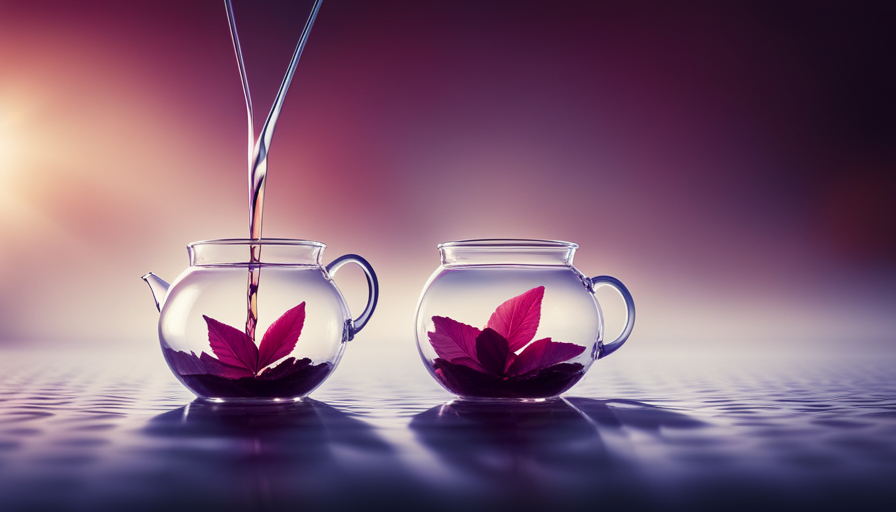
 Turmeric Tea4 weeks ago
Turmeric Tea4 weeks agoWhat Teas Have No Tannins
-

 Turmeric Tea3 months ago
Turmeric Tea3 months agoHow To Make Turmeric Tea With Powder
-
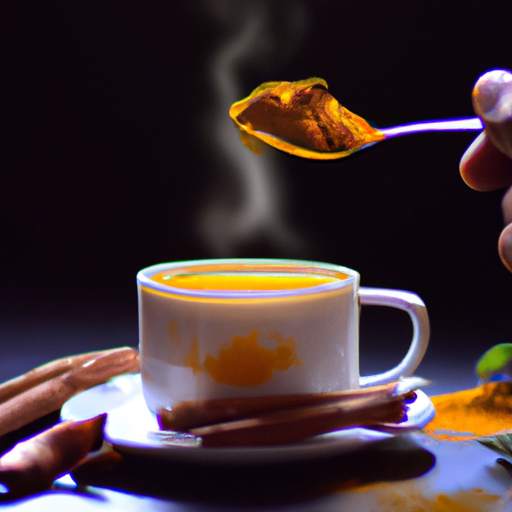
 Turmeric Tea2 months ago
Turmeric Tea2 months agoHow To Put Turmeric In Tea
-
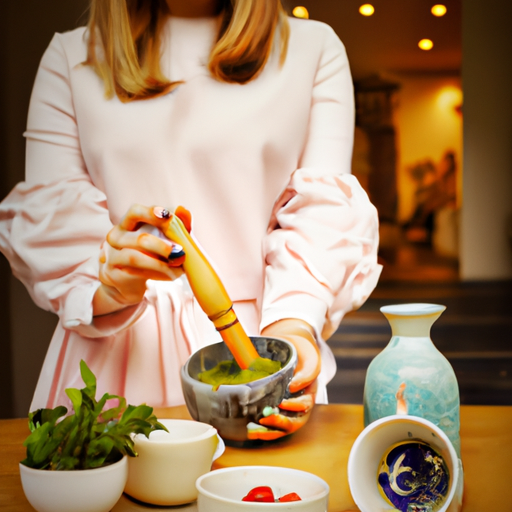
 Matcha Tea3 months ago
Matcha Tea3 months agoHow To Make Matcha Powder From Green Tea
-
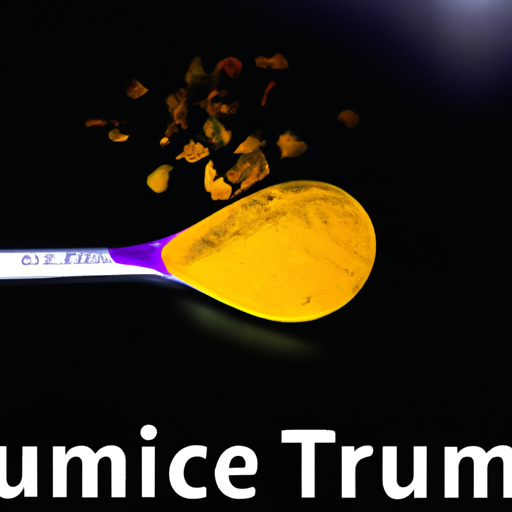
 Turmeric Tea2 months ago
Turmeric Tea2 months agoHow Much Is 500 Mg Of Turmeric In Teaspoons?
-
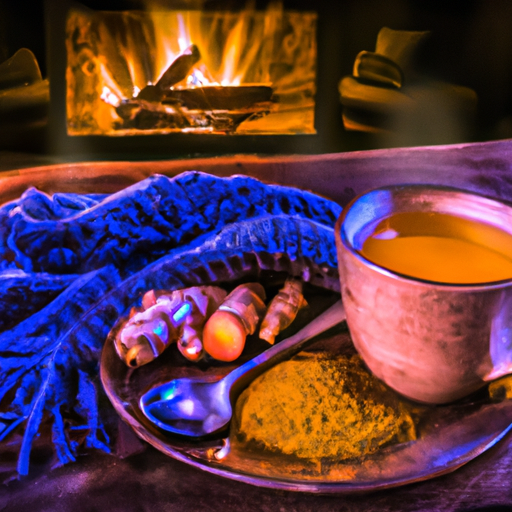
 Turmeric Tea3 months ago
Turmeric Tea3 months agoBrewing the Perfect Cup of Turmeric Tea
-

 Turmeric Tea2 months ago
Turmeric Tea2 months agoHow To Use Turmeric To Stop Periods
